What Web Designers Can Do to Help Clients Pivot During a Disruptive Event

When a crisis or other major disruptive event affects a business, they need to quickly pivot in order to survive. This post explores some ways you can help your clients out of a jam.
A recent survey from GetApp took a look at how small business leaders have adapted their business models in the face of COVID-19. And you know what the survey found?
51% of companies that pivoted their businesses saw their earnings increase during the pandemic versus only 16% who didn’t make any changes:

But that’s not all. 43% of business owners who pivoted plan to keep all the changes they implemented, while 96% will keep some of them. I don’t just think this is about future-proofing their businesses against another pandemic or disaster though.
Normally, when business runs smoothly, there’s very little time to make sweeping changes to a business. And why should a company even consider it? If “business as usual” works, then why rock the boat? But this is why so many businesses fall behind when it comes to digital transformation.
Thanks to the COVID-19 lockdowns and social distancing measures, businesses have had the time and capacity to embrace much-needed digital transformation. According to the survey, it’s appeared most commonly in the following forms:

As you can imagine, these kinds of things aren’t easy for a business owner or even their team to enact on their own. In fact, the survey revealed that 22% of business leaders say they didn’t have the skill to easily pivot and 14% didn’t know how to create new channels for themselves.
This is where you come in.
Let’s take a look at some of the things you should be ready to help with if your clients ever encounter a major disaster.
1. Add New Sections or Elements
In some cases, businesses will be able to continue as they did before, selling the same services or products. What changes is their general policy.
The best place to inform website visitors, shoppers, or other users about this is to change up the homepage. You might also need to adjust things like the Contact page if information like operating hours, availability, or new rules go into effect.
But let’s focus on the bigger changes you’ll be responsible for on the homepage.
This was the Lysol website in January 2020, two months before lockdown began in the United States:
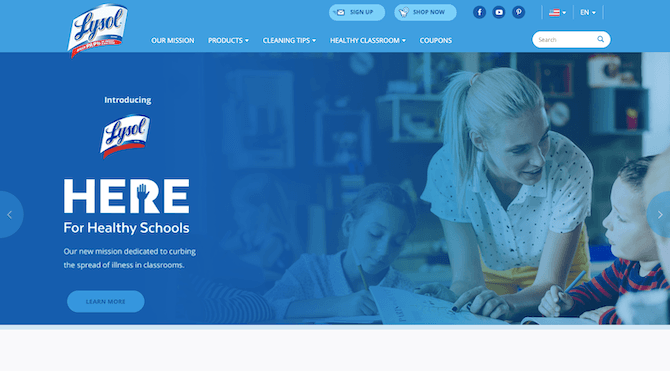
The homepage hero contained a rotating banner, with the first promoting Lysol’s initiative to curb “the spread of illness in classrooms.”
The rest of the homepage and site are pretty much what you’d expect for a company that sells cleaning supplies though. It shares information about its products while also providing cleaning tips for the home as well as schools.
This is what the Lysol website looks like in August 2020, in the midst of COVID-19:
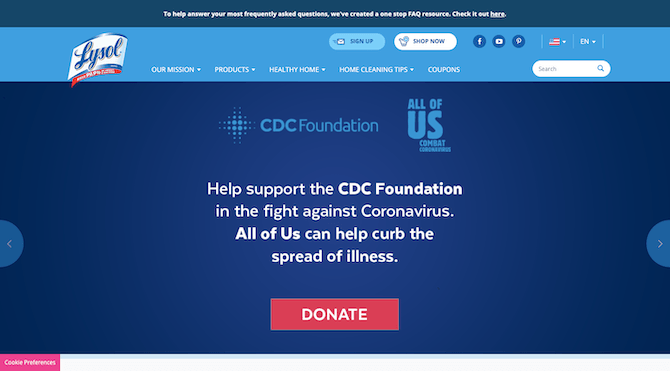
In the most recent version of the site, Lysol’s homepage banner contains only COVID-19-centric messages. Considering many schools around the world have turned into virtual classrooms, the messaging from just eight months ago is no longer relevant so this change was definitely needed.
Now, it’s not uncommon to update your site’s hero images as offers change, new products release, or big initiatives are launched. However, that’s not all Lysol changed, nor is it all you should be focused on either.
Compare the two navigations. In January, this is what the Lysol website featured in the top-level part of its menu:
- Our Mission
- Products
- Cleaning Tips
- Healthy Classroom
- Coupons
In August, the site removed “Healthy Classroom” and replaced it with “Healthy Home,” which now contains sub-pages specifically dedicated to the coronavirus. It also updated “Cleaning Tips” to “Home Cleaning Tips.” The order of the pages was also rearranged to reflect current priorities.
Notice, too, that there’s a sticky banner at the top of the latest site. It’s not necessarily coronavirus-related, but if you go to it, you’ll see why it’s there on a homepage that’s so clearly dominated by virus talk. It directs visitors to an FAQ page about the improper use of disinfectants, something which this company is in the best position to address.
So, don’t just focus on the most obvious part of the site. Sticky bars, menus, and even less frequently visited parts of the page or site should be carefully assessed for changes.
2. Add New Channels
One of the many things companies tend to put off is creating an omnichannel offering for their customers. It goes back to that old adage of, “If it ain’t broke, then why fix it?”
But a crisis like COVID-19 has shown business owners that no one can really afford to operate solely through the channels that they alone prefer to conduct business through. For one, consumers expect a variety of options that make it quick, convenient, and cost-effective to buy from a company. To pass on those channels is to pass on more revenue.
Secondly, there’s no such thing as a disaster-proof channel. For instance, let’s say there was a hurricane in your client’s city and it wiped out power for a couple days. No internet, no phone. So, what does the business do if that’s their main way of communicating with customers? This is why backup channels are useful for every communication, sales, and delivery channel.
Let’s look at the example of Walgreens. This was what appeared below the fold on the website in January 2020:

This makes sense for a retail pharmacy website. There’s a good mix of helpful navigation elements (like shopping by popular categories) as well as advertisements for the most recent in-store promotions.
In August 2020, Walgreens added a new section to this part of the homepage:
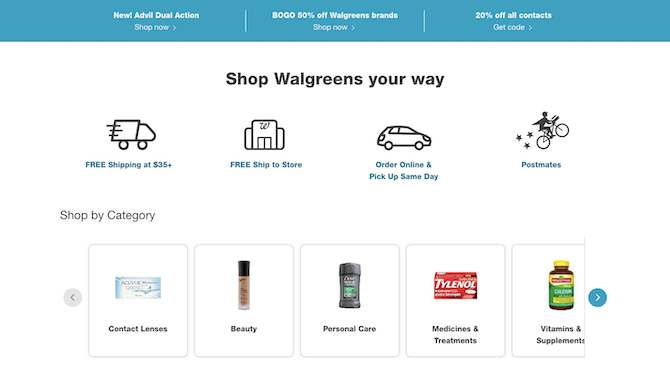
For the most part, everything remains the same, with the exception of this section. Walgreens now offers customers a variety of ways to shop with them:
- Ship to the customer’s home
- Ship to the store (in case the customer isn’t home and it’s more convenient to pick up at the store)
- Order online and pick up the same day at the store
- Postmates
If you visit any of these informational pages, you’ll notice that each was created in May 2020. So, it looks like it took about two months after the lockdowns began for Walgreens to craft this omnichannel solution.
It’s very well-thought-out and has likely done a good job of putting customers’ minds at ease after the tumultuous period when essential items like toilet paper, disinfectant, and hand soap were impossible to find. Now, they have a variety of options at their disposal to get whatever they need and they’re all clearly spelled out on the website.
3. Virtualize Their Services
I get why many businesses have continued to deliver their services strictly in person, despite what the internet and having your own website enables them to do. There’s something special about that one-on-one engagement with a customer that’s very difficult to reproduce online.
That said, this latest crisis has demonstrated to business owners that they can’t rely on that as a dependable business model anymore. While the option can and still should exist, virtualized service options must be created (1) for customers who prefer to receive them that way and (2) to protect their businesses from future restrictions on in-person transactions.
This virtualization of services has a ton of applications, too. So, the more widespread the adoption is across industries, the more comfortable and confident consumers will become with them. This, I suspect, will make virtual services a very attractive option in the years to come.
As far as what you need to build out, it depends on how the virtual service is to be provided (e.g. through the site, over a Zoom session, by watching a video). Let’s look at some examples.
Real estate companies were obviously in a bind at the start of COVID-19 when countries went into lockdown. But that doesn’t mean that people don’t need to buy or sell their homes or rent new ones.
That’s why companies like Long & Foster Real Estate have added new sections for virtual home buying and selling to their navigation:

Not only is this information useful for SEO purposes, but it also can help put prospective buyers’ or sellers’ minds at ease about the safety of these transactions during a pandemic.
When they’re ready, they can use a form on the website to schedule a virtual tour with an agent:
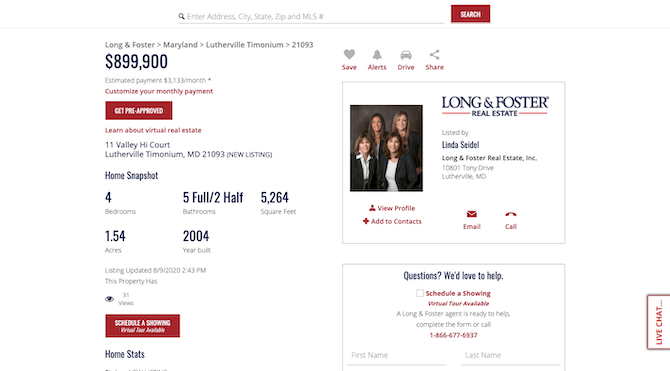
The events industry is another one that’s had to do this. Bavaria Downs, for instance, has turned its normal “Tours” page into one where interested couples-to-be can schedule a virtual tour of the property:

Another way to handle this is to sell virtual services through the site and provide a link to the virtual classroom as Ashes Yoga does:

Students purchase their class passes through an online portal and then access the Zoom classes through the link provided.
And speaking of students, higher education institutions have also had to get creative about getting prospective students to check out their campuses. Bates College, for example, provides various options for this:
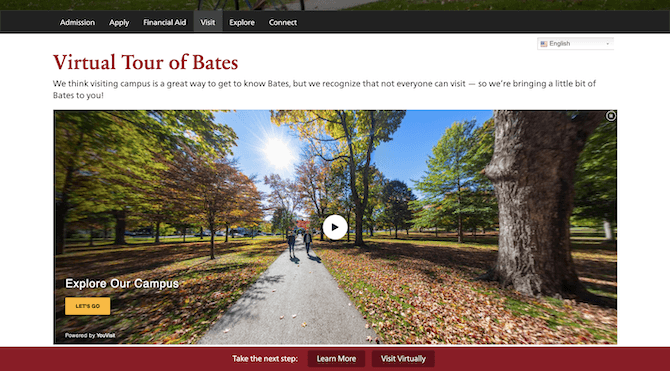
Students can take a guided and interactive 3D VR tour, they can read about the campus on the website, or they can schedule a virtual visit. This option is also useful for arts, entertainment, and historical organizations that want to keep prospective visitors engaged even if they can’t visit in person just yet.
4. Add New Products to the Store
What’s interesting about this use case is that it’s not always necessitated by a decrease in business during a crisis.
Take, for instance, a marketplace like Etsy. Even if people aren’t spending as much as they were before the pandemic, a store like this will continue to make enough sales until things return to normal. And, yet, the website has since been updated to include a new category for, you guessed it, face masks:
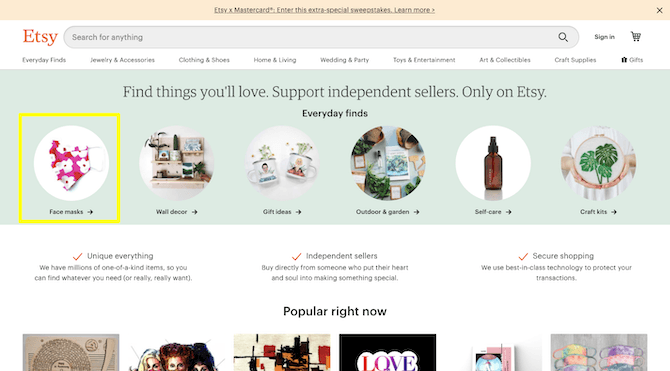
For the most part, everything in this digital marketplace remains the same in terms of design, content, and navigation. However, the addition of something like this to the homepage and listing of categories is worth paying attention to as it shows how attentive the Etsy store owners are to their customers’ needs by providing timely suggestions and tools to get around the site.
Now, this isn’t always the reason why businesses add new products in times of crises. Brick-and-mortar businesses, for instance, may need to sell their products a different way or to turn existing services into products in order to survive.
Many in the restaurant and liquor industry had to do this while waiting for lockdown and social distancing orders to lighten up.
One such business that did this was The Providence Brewing Company. In January 2020, the brewery gave visitors in-person tours of their facilities along with selling their beer products there.
The website then served as a place to educate beer drinkers about the beers they had available, to educate them on the history of their brewery, and to sell merchandise like clothing and branded gear:

After the COVID-19 restrictions went into place, the website was completely redone and now advertises different services and products:
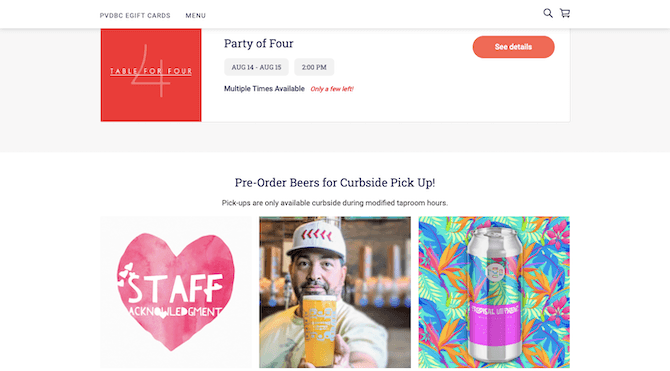
The site has now become a vehicle for selling things like:
- Socially distanced beer garden reservations
- Curbside pickup of pre-ordered beer
- Gift cards
This just goes to show you that there are different ways to pivot during a crisis and some options may require more intervention from you as a web designer than others. But if you can take the vision your clients give you and execute it to perfection, you can help them get through the current crisis in one piece.
Wrap-Up
There are a number of things that could send a business into meltdown and its owner into recovery mode. A natural disaster that destroys their brick-and-mortar operational center. A pandemic that forces mass lockdowns. Other factors like an economic downturn or changes in government legislation can also send businesses reeling from changes they might not have predicted and weren’t prepared for.
But business decisions don’t immediately become a reality once a new policy or strategy is in place. Businesses have to implement steps that not only set them in motion, but also keep prospects and customers informed of the business disruption and ensuing actions being taken.
And while web designers can’t help clients fix things internally, they have a big role to play in communicating these updates through their websites. Just make sure you have the right design systems and collaboration software in place ahead of time so you can implement these changes smoothly and swiftly.

Suzanne Scacca
A former project manager and web design agency manager, Suzanne Scacca now writes about the changing landscape of design, development and software.
